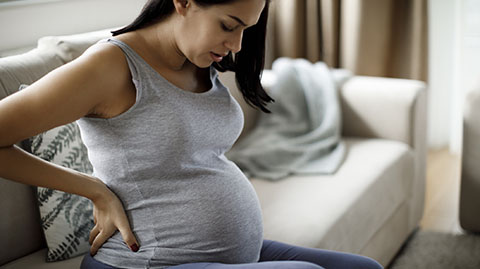
A pregnant client vomits and loses consciousness in the middle of a massage. The therapist shows remarkable presence of mind and everything worked out fine—but what on earth happened? Would it have been possible to predict such a thing?
We call out the big guns for this one: Carole Osborne, author of Pre- and Perinatal Massage Therapy, A Comprehensive Guide to Prenatal, Labor, and Postpartum Practice, took some time to talk me through this so I could bring some true expertise to this discussion.
Links:
For more information about Carole Osborne, visit:
www.bodytherapyeducation.com/about-body-therapy-education/instructors/carole-osborne
“Breathing, Positioning & Blood Clots: Doing No Harm with Prenatal and Postpartum Massage Therapy During the Coronavirus Pandemic,” by Carole Osborne, Massage & Bodywork magazine, September/October 2020, page 54:
www.massageandbodyworkdigital.com/i/1276187-september-october-2020/56


This episode sponsored by Anatomy Trains and Books of Discovery.
00:00 Speaker 1: Ruth Werner's best-selling book, A Massage Therapist's Guide to Pathology, is a highly regarded comprehensive resource that sets the standard for pathology education. Written for massage therapy students and practitioners, this groundbreaking resource serves up a comprehensive review of the pathophysiology signs, symptoms and treatment of more than 500 diseases and disorders. Learn more at booksofdiscovery.com.
[music]
00:39 Ruth Werner: Hi, and welcome to I Have A Client Who, pathology conversations with Ruth Warner. The podcast where I will discuss your real life stories about clients with conditions that are perplexing or confusing. I'm Ruth Warner, author of A Massage Therapist's Guide to Pathology, and I have spent decades studying, writing about and teaching about where massage therapy intersects with diseases and conditions that might limit our client's health. We almost always have something good to offer even with our most challenged clients, but we need to figure out a way to do that safely, effectively, and within our scope of practice, and sometimes as we have all learned, that is harder than it looks.
01:25 RW: This episode is being recorded during the week of Halloween 2020, could there be a scarier time? This comes from a massage therapist in Washington State, who shares this story. "I have a client who is a 37-year-old pregnant woman, referred for lower back pain. She was in her fourth month of pregnancy when she came in for a massage after a glucose tolerance test, it was her fourth massage of the eight that were prescribed by her obstetrician. We were about 20 minutes into the treatment where she was supine with a pregnancy wedge behind her, when her eyes rolled back in her head and she vomited. I called her name and she continued to vomit, seeming to lose consciousness, and I said, 'I'm going to call the medics.' There is no response from her, and I made the call and got her onto her side to avoid the aspiration of the vomit.
02:22 RW: "I kept calling her name and she was out for between 30 to 90 seconds, which seemed like an eternity. The medics came, checked her out and left. She asked that I call her husband and her mother who were both in the area, and both responded to come and pick her up. Her blood sugar was not tested by the medics. She was extremely apologetic, and I was able to ask her if she had eaten anything after her glucose tolerance test and she had not. I reassured her, helped to clean her up and get her dressed and waited for her husband and her mother. I suggested that she follow up with her obstetrician to make sure that there were no other supports that she needed for that day or evening."
03:08 RW: Before we go any further, I wanna offer my thanks to this very generous massage therapist for sharing this important story, and I want to invite you to share your I Have A Client Who stories. You can do that by sending them to me at ihaveaclientwho@abmp.com. That's ihaveaclientwho, all one word, all lowercase, @abmp.com. What a story. I don't know if we have the same sense of responsibility about any clients, the way we do about our clients who are pregnant, and what happened here shows how extremely important it is to be knowledgeable about pregnancy, for sure, but also about complications related to pregnancy.
04:00 RW: There are about a billion different variables that might have weighed into the decisions that this massage therapist made, we're gonna unpack just a handful. Right off the bat, I wanna acknowledge that I am not an expert at all about pregnancy and perineal massage, and when I have questions about working with this population, I go to my friend Carol Osborn, who is truly an expert on this topic. I will connect you with her website in our show notes where you can find a link to sign up for classes about pregnancy, massage and other topics, and you can also access her wonderful textbooks. Her most recent article on working with pregnant clients during the pandemic that appears in the September-October issue of Massage And Bodywork Magazine is also a must read.
04:48 RW: So as I was thinking about this massage therapist and her client, I was lucky to have a call with Carol and I described this case with her, and the first thing that we both wanna say is that this massage therapist handled these very scary events that unrolled during this massage session amazingly well. Carol said specifically, "She did everything I would have done, she could not have done it better, except I probably would have tried to get the medics to stay until the client's family arrived. But really, given the situation, she did a great job." We also have some thoughts.
05:28 RW: The biggest red flag in this description for us was the fact that the client had just had her glucose tolerance test. If any of our listeners have ever had a glucose tolerance test, you'll be familiar with this. Imagine drinking a great big glass of Mountain Dew syrup first thing in the morning on an empty stomach. Then over the next couple of hours, someone draws your blood to see how well you manage this huge influx of sugar, and then they send you on your way. The purpose of the glucose tolerance test is to identify pregnant people who are at risk for gestational diabetes, which can be a really serious situation and with dangerous complications for both mother and baby, but even for people who are not at risk for gestational diabetes, this procedure puts a pregnant person's ability to manage blood sugar through a really hard workout.
06:23 RW: And our first guest in hearing what this client went through is that she might have had a really massive blood sugar crash, in other words, she had this influx of sugar with her glucose tolerance test, she secreted a huge walk of insulin to lower her blood sugar, and now a while later, she has dangerously low blood sugar and she hasn't eaten. Having low blood sugar can make you woozy, dizzy, disoriented, cranky, nauseated, ask me how I know. And in very extreme cases, a person could pass out. Let's add to the scenario that massage therapy has been demonstrated to contribute to a drop in blood glucose. So if this client is already struggling along with low blood sugar, the massage would almost certainly make it worse.
07:16 RW: So the first upshot is that it would have been a wise if the therapist knew that this client had just come from taking a glucose tolerance test to offer her something to eat. It could be as simple as a cracker, a cup of juice, a little piece of candy, even a cough drop. But giving her system something to work on while her blood sugar is so low would probably have been a good idea. I asked Carol what if the client doesn't wanna eat, and her response was that then, she'd have to make a judgment call based on what she observed about this person and her general well-being, but really, this client needs to eat something. However, because it's never that simple, there are some other factors that might also have contributed to this client's loss of consciousness. From this description, we know that the client was in her fourth month of pregnancy and she was receiving massage by prescription from her obstetrician, and that's great.
08:15 RW: The therapists said she had a pregnancy wedge under her while supine, it was a large wedge that put her in sort of a semi-reclining position rather than a small one under her left hip, which is sometimes used in pregnancy massage. At four months along, it is conceivable that this fetus could have been big enough to rest on the venae cavae, causing a situation called supine hypotensive syndrome, and what this means is the blood supply from the lower extremities back toward the heart and the brain is compressed, and this can lead to all kinds of consequences including nausea and loss of consciousness.
08:53 RW: Now, most four month fetuses are probably not big enough to have this kind of effect, but it is possible that this was a particularly big baby or that the size and shape of the client may have contributed to this risk or even the health of her cardio, respiratory function has a role to play in this scenario. The point is, there's more than one possibility for factors that may cause a pregnant person to vomit and pass out.
09:18 RW: Lastly, well, Carol and I agreed that this massage therapist showed amazing presence of mind in managing this crisis, the whole scenario points to the obvious conclusion that working with pregnant clients means we have to weigh so many more variables than we do for clients who were not pregnant. The demands on our critical thinking skills are exponentially expanded in this situation where we feel an increased level of responsibility to provide a safe experience for the client and also for the baby.
09:50 RW: To conclude, this massage therapist was in a really tricky situation. As it turns out, she does have advanced education in pregnancy massage, and it happened with Carol Osborn, but it happened in 1988, and we've learned a few things both about pregnancy and about massage therapy in the context of pregnancy since then, which just goes to show that it's worthwhile to keep our education current, it's wonderful that the therapist has a relationship with the client's obstetrician that allows her to work in collaboration, her knowledge, her experience and her quick thinking led to the best possible outcome for this client, who was lucky to have her.
10:34 RW: Hey everybody, thanks for listening to I Have A Client Who, pathology conversations with Ruth Werner. Remember, you can send me your I Have A Client Who stories to ihaveaclientwho@abmp.com. That's ihaveaclientwho, all one word, all lower case, @abmp.com. I can't wait to see what you send me and I'll see you next time.
11:02 S1: Anatomy Trains is excited to announce a new on-demand video course with Tom Myers coming soon. Deeper Ground: Restoration and Vitality for the Female Pelvis. Reach your deeper ground of embodied awareness and strategic confidence with this four-hour tour of the female pelvis, including its key points and unique challenges. Course highlights include, hands-on palpation certainty and technique review for the major muscle groups, assessments and techniques for posterior and anterior pelvic floor, so as complex and diaphragm, common perinatal biomechanical issues explained, and much more. Sign up for the Anatomy Trains newsletter at anatomytrains.com to be notified when the course is available.